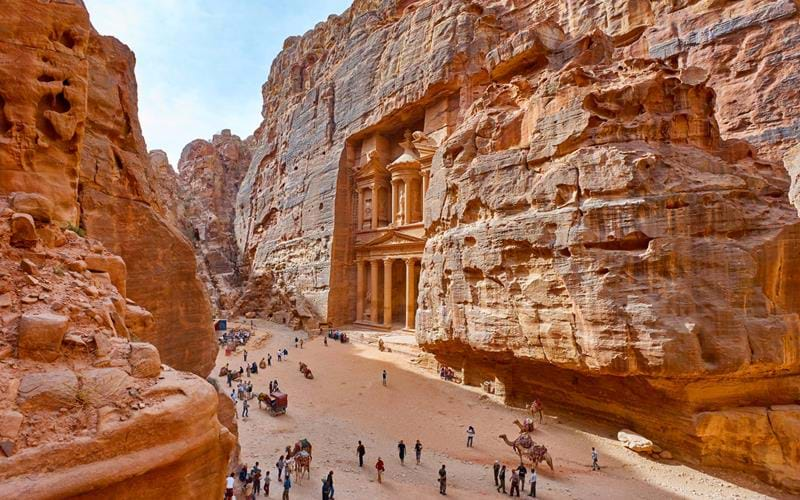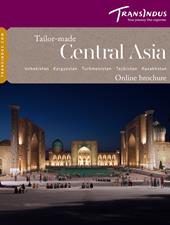Places Visited: Amman – Petra – Wadi Rum – Amman
Join us on this compelling 8-day tour of Jordan’s scenic and cultural highlights, featuring the cream of the country’s
extraordinary desert landscapes and Greco-Roman ruins. It begins in the capital, Amman, with a visit to Desert Castles and the Citadel to see the still beautiful ruins of the city’s Roman and Byzantine periods. Day trips to the sublime colonnaded Forum at Jerash as well as spa break at the Dead Sea take up remaining time in Amman. From there, we travel to Petra to visit the incredible ‘Rose City’ built by the ancient Nabateans. Continue to the moonscapes of Wadi Rum before returning to Amman for overnight stay and flying back home.
This tour is operated by our partners in country. The group size may vary from 2 people to 25 or more.
Holiday Types
Cultural Holidays
Travel Arrangements
- Group Size 2 - 25
- Internal Travel Internal travel by road
- Accompanying Guide English-speaking guides
- Accommodation Accommodation for 7 nights as listed
- Meal Plan Half Board
Itinerary for Jordan Experience
Amman
You will be met at Amman airport and transferred to Liwan Hotel or similar for two nights’ stay.

The multicultural city of Amman in Jordan is ideal for cultural immersion and for exploring traditions of the Middle East. There are many galleries and museums, ideal for those interested in digging deeper into the history of the region.
The markets are great for buying local produce and traditional handicrafts, the souks are dazzling with an array of handmade jewellery, whilst the modern-day boutiques juxtapose them.
Accommodation Options
Amman
This morning, visit the Desert Castles – the spectacular early Islamic art complexes with their fine mosaics, frescoes, stone and stucco carvings inspired by the best Persian and Greco-Roman culture. In the afternoon, visit Amman’s magnificent Citadel which houses several impressive structures like the Temple of Hercules, Umayyad Palace, Byzantine church, Archaeological Museum, and the Folklore Museum. Later visit downtown Amman to see the Roman Theatre.

Amman's citadel, a UNESCO World Heritage Site, sits at 850 metres above sea level, towering above the capital city. The site comprises of a 1700m long wall that dates back to the Bronze Age, the iconic Temple of Hercules built by the Romans, and the Umayyad Palace dating back to the 7th and 8th centuries. The Archeological Museum has a fascinating collection of artifacts dating back to the Bronze Age
Accommodation Options
Amman – Jerash – Amman
After breakfast, start your day with a visit to Jerash, ‘the Jewel of the North’ - one of the largest and most well-preserved sites of Roman architecture in the world outside Italy. Then continue to Ajloun Castle – a well-preserved 12th century Muslim castle. Return to your hotel in Amman.

The ruins of ancient Gerasa tumble from the arid hillside above the modern town of Jerash, Jordan. Two-thousand years ago, this was a thriving provincial capital of around 20,000 people, complete with a grand amphitheatre, colonnaded squares, triumphant gateway and hippodrome.
Considering it was roughed up by the Persians, the Crusaders and a couple of earthquakes, the site is in remarkable condition. Highlights include the archway dedicated to the emperor Hadrian, and some superb mosaic church floors.
Accommodation Options
Amman - Dead Sea - Amman
This morning, drive to the Dead Sea visiting Iraq El Amir en route. One of the most spectacular natural and spiritual landscapes in the world, the Dead Sea is the lowest point on Earth, at 400m below sea level. Spend some time at the Dead Sea before returning to your hotel in Amman.

Ancient royals from Herod to Cleopatra numbered among those who availed of the Dead Sea’s curative powers. The secret of its success, then as now, is a rich cocktail of minerals and salts caused by evaporation of the river water flowing into it.
After a bob in the extra-buoyant waters of the Dead Sea, continue to Madaba and the church of St George. The church itself was built in 1896 AD, and is one of many churches to be blessed by a mosaic masterpiece in the city.
The last stop of the day is Mount Nebo with its sweeping views of the Dead Sea, Israel and the Palestinian Territories. This is where Moses is said to have seen the Promised Land, a land he was himself forbidden to enter. It's believed that he died aged 120 and was later buried in the area, although the exact location of the burial is unknown.
The incredible remnants of a 4th century monastery and The Moses Memorial Church, with beautifully preserved Roman-mosaic floors and stained glass windows sit at the peak. Six tombs etched into the rocks lie below along with a host of sculptures, old and new dot the countryside including a cross-serpentine sculpture, symbolising a serpent and Christ’s crucifixion.
Accommodation Options
Amman - Madaba - Petra
Drive along the 2000-year-old King’s Highway to Madaba, ‘The City of Mosaics’. See the 6th Century map of the Holy land laid out on the floor of the church of St George. Proceed to Mount Nebo, known as the burial place of Prophet Moses. Drive on to Petra visiting en route Crusader Castle in Kerak. Stay overnight at Petra Elite or similar hotel.

Given the popularity among foreign visitors today, it’s hard to believe Petra remained forgotten by the outside world until 1812, when it was re-discovered by a Swiss explorer. Imagine Johann Burckhardt’s emotions when, after being led down the twisting, narrow defile deep in the desert, he first set eyes on the finely sculpted tombs and temples of the Nabataean kings who ruled here in the 3rd century BC.
Hollowed by hand from the sandstone cliffs, the structures were badly damaged by an earthquake in Roman times, and later squatted by local Bedouins, whose descendants nowadays ferry visitors to the site by camel. The real highlight of visits today is the Night Walk, when you can savour the Treasury’s ancient stonework by the light of flickering flames.
Accommodation Options
Petra – Wadi Rum
This morning, explore the “Rose Red City” of Petra - a treasure trove of the ancient worldrediscovered in 1812. Later drive to Wadi Rum, Jordan’s vast and echoing desert. Stay overnight at Siq Rum Desert Camp or similar accommodation.

Wadi Rum offers a fantastic opportunity to experience the desert in a Middle Eastern culture. The natural landscape is home to monolithic rocks, some of which reach 1,750 metres high, water holes, and canyons. Rock inscriptions dating back 4,000 years old can be found.
The vast expanse of land is tranquil, unspoilt by modern development, and is inhabited by the Bedouins who maintain a nomadic lifestyle. Various excursions are available, including visits to the natural Burdah Rock Bridge which is the tallest in Wadi Rum at a measurement of 35 metres, and the Seven Pillars of Wisdom.
Accommodation Options
Amman
Enjoy a Bedouin 4x4 jeep ride exploring the stunning moonscape. Visit the Seven Pillars of Wisdom, walk through narrow canyons and climb up the large rocks for views of this spectacular area. Later drive to Amman and stay overnight at Landmark Hotel or similar.

Jordan's desert castles, beautiful examples of both early Islamic art and architecture, stand testament to a fascinating era in the country's rich history. Their fine mosaics, frescoes, stone and stucco carvings, and illustrations, inspired by the best in Persian and Graeco-Roman traditions, tell countless stories of life as it was during the 8th century. Called castles because of their imposing stature, the desert complexes actually served various purposes as caravan stations, agriculture and trade centres, resort pavilions, and outposts that helped distant rulers forge ties with local Bedouins.
Accommodation Options
Amman
Transfer to Amman airport for your onward flight.
Accommodation Options
Group Tour 8 days from £1295 per person
What's included
- Arrival and departure transfers
- Internal travel by road
- Accommodation for 7 nights as listed
- English-speaking guides
- Entrance fees at the monuments
2025/2026 tour prices for Jordan Experience
| DEPARTURE DATE | PRICE PER PERSON | SINGLE ROOM supplement | AVAILABILITY | |
| Sat 26 Jul 2025 | £1295 | £495 | Please call us | |
| Sat 16 Aug 2025 | £1295 | £495 | Please call us | |
| Sat 04 Oct 2025 | £1495 | £495 | Good | |
| Sat 25 Oct 2025 | £1495 | £495 | Good | |
| Sat 08 Nov 2025 | £1495 | £495 | Good | |
| Sat 22 Nov 2025 | £1495 | £495 | Good | |
| Sat 13 Dec 2025 | £1295 | £495 | Good | |
| Sat 10 Jan 2026 | £1295 | £495 | Good | |
| Sat 24 Jan 2026 | £1295 | £495 | Good | |
| Sat 07 Feb 2026 | £1295 | £495 | Good | |
| Sat 21 Feb 2026 | £1295 | £495 | Good | |
| Sat 07 Mar 2026 | £1295 | £495 | Good |
Places and Experiences in this tour
Plan your Next Adventure
With the Summer almost upon us, now is the time to begin planning your next summer adventures in Asia. Our Travel Specialists are ready to take your call and discuss the adventure you have been dreaming of.
Or call us on 0208 566 3739
















